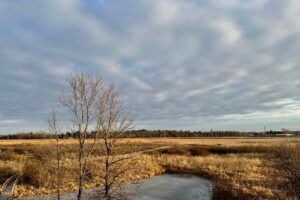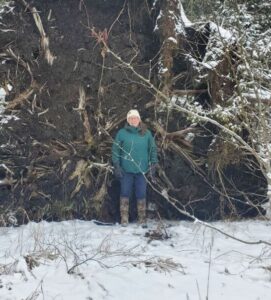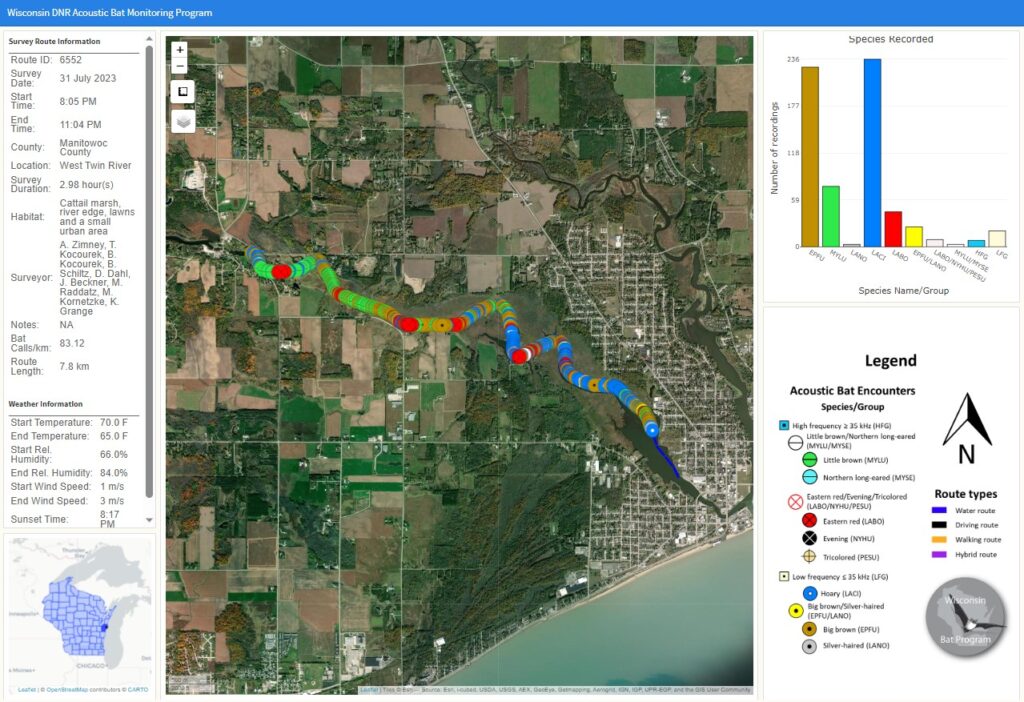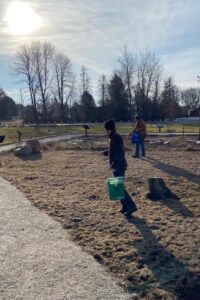
The world seems to have gone dormant now. Leaves are off the trees, wildflowers have withered, frost or snow covers the ground most mornings, and many birds are gone south. Even though it seems nature has taken a step back, this is still a very important time of year for native plants and an excellent time for them to be established.
If you think about it, late summer and fall are a time of abundant blooms. Hundreds of species of plants which began the summer as sprouts or seedlings mature just as the population of pollinating insects is at its peak. Unbridled fertilization takes place on an enormous scale, resulting in the production of millions of seeds to being the next generation of annuals and those who will colonize areas of available space. It takes a while for seeds to develop, but when they do, they are released to drop to the soil or float on the breeze to land in a new location. A couple of weeks ago, there was such a day when one could see thousands of seeds drifting like snowflakes all around- probably the seeds of goldenrods seeking new homes. Only a small fraction find a friendly place to land and grow, potentially. They settle down and wait.
Some which ripen early enough will germinate in mild weather and establish themselves before winter comes. When the snow melts they are ready to soak up spring sunshine and grow quickly, getting a head start. Many of the aggressive and invasive plants do this, and their green rosettes of leaves stand out among the brown and white of the season. Some, like the white oaks, germinate and slowly grow roots during the winter, while red oaks wait until spring to sprout, needing to sleep before they grow.
Some plants need to go through a cold period before they can germinate, a time referred to as cold stratification. Many wildflowers have this strategy, perhaps ensuring that they won’t germinate too early, say during a mild spell in fall when they might lose their resistance to the cold winter weather to come. They require months of cold and moisture, which somehow stimulates them to grow when warmth finally comes. For this reason, late fall is a very good time to sow the seeds of many native plants. That is what our staff did today at Zander Park in Two Rivers.
The old playground area at Zander Park is being re-done. It was always very wet, having been constructed on an old Lake Michigan shoreline swale- a wet depression between old beach ridges. Water stands in areas of the park for long periods in fall, spring, and summer. The old play area had been filled, and the Lester Library and Two Rivers Parks and Recreation Dept. had an idea to construct a story trail with nature-based play features. They asked our Woodland Dunes team to help with the establishment of native wildflowers to cover the area around the trail. A wildflower meadow, with the butterflies, dragonflies, and other wildlife it attracts, is a great surrounding for a family oriented walk, and another acre of lawn converted to native wildflowers and other plants can be important to the survival of a number of wildlife species. In addition, a number of native trees were also planted to replace ash that were taken down.
The site was prepared by doing some treatment to eliminate some of the lawn grasses, and it was immediately apparent that all was not lawn- there were already some sedges and rushes, lovers of wet soil, growing on the site and were allowed to remain. We waited until most of the mild weather had past and the early snow had melted. Then, in a line, several of us walked over the site scattering the seed by hand. Rain forecast in the next day or two will help incorporate the seed into the mud, and the snow after will protect it during the coldest months. Under the snow, the soil will freeze, then thaw, helping to mix the seed just below the ground surface, and when warm spring rains come the seeds will know to germinate.
Then, over the next several years, the plants, dozens of different species, will slowly grow and develop. Many are perennials, taking a while to establish themselves, so each year the park will take on a different personality as different plants grow and bloom. We can try to predict what the site will look like, but nature makes the final call, and we look forward to watching the park develop over time.
Native wildflower mixes can even be sown over the snow, the seeds gradually working their way down over winter to contact the soil, again repeating a natural process millions of years in the making. Some of our most successful plantings at Woodland Dunes were snow-seeded. The key is to pay attention to nature, and treat the seeds as they want to be treated as though they are falling from their parent plants in the wild. It’s very different than the way we are used to planting, but is a very effective means of establishing new native plantings.
Dr. Doug Tallamy of the University of Delaware promotes the concept of a “Homegrown National Park,” comprised of many individual yards planted with at least some native trees and wildflowers. If enough landowners added native plants to their land that large collective area would benefit wildlife as much or more than a new national park. It’s not that hard to do, and now is a good time to start.
Photo- Max and Kennedy from the staff at Woodland Dunes spread wildflower seed at Zander Park in Two Rivers.
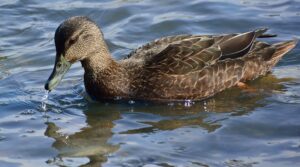 As the mild December rolls along, the time comes for the annual Christmas Bird Counts. Originally begun in the eastern US 124 years ago, they have been conducted in Manitowoc County since 1974, when Bernie Brouchoud first rounded up volunteers to count birds here on behalf of Woodland Dunes. That makes 50 years of winter bird counting, centered in four 15-mile diameter circles in our county, with many thousands of observations of our local birds found here during the winter season. This is one of the first citizen-science projects as they are known, where knowledgeable volunteers collect data which is later used for scientific research. It’s quite a success story, with many thousands of people participating. Last year, more than seventy-nine thousand counters participated in 2,625 counts in the US, Canada, the Caribbean, South America, and on Pacific islands.
As the mild December rolls along, the time comes for the annual Christmas Bird Counts. Originally begun in the eastern US 124 years ago, they have been conducted in Manitowoc County since 1974, when Bernie Brouchoud first rounded up volunteers to count birds here on behalf of Woodland Dunes. That makes 50 years of winter bird counting, centered in four 15-mile diameter circles in our county, with many thousands of observations of our local birds found here during the winter season. This is one of the first citizen-science projects as they are known, where knowledgeable volunteers collect data which is later used for scientific research. It’s quite a success story, with many thousands of people participating. Last year, more than seventy-nine thousand counters participated in 2,625 counts in the US, Canada, the Caribbean, South America, and on Pacific islands. As the mild December rolls along, the time comes for the annual Christmas Bird Counts. Originally begun in the eastern US 124 years ago, they have been conducted in Manitowoc County since 1974, when Bernie Brouchoud first rounded up volunteers to count birds here on behalf of Woodland Dunes. That makes 50 years of winter bird counting, centered in four 15-mile diameter circles in our county, with many thousands of observations of our local birds found here during the winter season. This is one of the first citizen-science projects as they are known, where knowledgeable volunteers collect data which is later used for scientific research. It’s quite a success story, with many thousands of people participating. Last year, more than seventy-nine thousand counters participated in 2,625 counts in the US, Canada, the Caribbean, South America, and on Pacific islands.
As the mild December rolls along, the time comes for the annual Christmas Bird Counts. Originally begun in the eastern US 124 years ago, they have been conducted in Manitowoc County since 1974, when Bernie Brouchoud first rounded up volunteers to count birds here on behalf of Woodland Dunes. That makes 50 years of winter bird counting, centered in four 15-mile diameter circles in our county, with many thousands of observations of our local birds found here during the winter season. This is one of the first citizen-science projects as they are known, where knowledgeable volunteers collect data which is later used for scientific research. It’s quite a success story, with many thousands of people participating. Last year, more than seventy-nine thousand counters participated in 2,625 counts in the US, Canada, the Caribbean, South America, and on Pacific islands.
